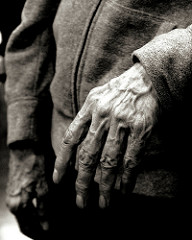 The Gospels of Mark and Luke both record the account of a man with a withered hand entering into the Synagogue. Twelve years ago I preached about this very subject in which this man was healed as he displayed his affliction. In more recent times, however, I have heard some erroneous conclusions about the scripture. Some report that the man was concealing his hand when he entered the Synagogue. However, the scripture gives no indication that he came in hiding. In fact, both gospels tell us that those around him knew his condition and watched closely to see if Jesus would heal him. They were wondering what the Lord might do on the Sabbath day with this man who had a withered hand. They were always looking to trap Jesus in a conflict, but it was Rabbinic tradition, not Old Testament law, which forbade the practicing of medicine on the Sabbath day unless the person was on the verge of death. This too has been misinterpreted. It was the rabbis who were angry at the Lord’s actions that day because he violated their law, not the Law of Moses.
The Gospels of Mark and Luke both record the account of a man with a withered hand entering into the Synagogue. Twelve years ago I preached about this very subject in which this man was healed as he displayed his affliction. In more recent times, however, I have heard some erroneous conclusions about the scripture. Some report that the man was concealing his hand when he entered the Synagogue. However, the scripture gives no indication that he came in hiding. In fact, both gospels tell us that those around him knew his condition and watched closely to see if Jesus would heal him. They were wondering what the Lord might do on the Sabbath day with this man who had a withered hand. They were always looking to trap Jesus in a conflict, but it was Rabbinic tradition, not Old Testament law, which forbade the practicing of medicine on the Sabbath day unless the person was on the verge of death. This too has been misinterpreted. It was the rabbis who were angry at the Lord’s actions that day because he violated their law, not the Law of Moses.
In context, and true to the Word, this man did not unravel his hidden hand suddenly. Rather the man came like in times before with an unconcealed affliction. Jesus stood up to prove His power and authority over every sickness, even that of a withered hand, but there was more to the matter than the Lord’s power over sickness and disease. Jesus was displaying that He was greater than their collective thought, even those Rabbinic traditions: He was showing that He was Lord of the Sabbath.
 Jesus gave the man with the withered hand two commands: “Stand forth” and “Stretch forth thy hand.” The first command entailed humility and confession. He had to humble himself in order to stand in the open before them all. Consequently his action was a sign of confession that indeed he was afflicted. The man had to swallow his pride and allow the Lord to present him among them. This may have been the most difficult step; to be singled out. The second command was an act of faith, which simply meant that he was responding to the Lordship of Jesus Christ. To stretch out his hand was akin to believing for the miracle. The Bible says it like this, “And he stretched it out: and his hand was restored whole as the other.”
Jesus gave the man with the withered hand two commands: “Stand forth” and “Stretch forth thy hand.” The first command entailed humility and confession. He had to humble himself in order to stand in the open before them all. Consequently his action was a sign of confession that indeed he was afflicted. The man had to swallow his pride and allow the Lord to present him among them. This may have been the most difficult step; to be singled out. The second command was an act of faith, which simply meant that he was responding to the Lordship of Jesus Christ. To stretch out his hand was akin to believing for the miracle. The Bible says it like this, “And he stretched it out: and his hand was restored whole as the other.”
I cannot tell which command was more important only that they acted in concert with one another. Humility and healing are chronological. Obedience and faith resulted in deliverance. In order to be whole might mean that you must be willing to come forward, even though everyone knows your need. It might mean that you come to the forefront for prayer, or be wiling to be seen among the believers. Pride often keeps us from presenting our known need. Even private prayer might be used as a tool to remove ourselves from the open, but to humble yourself means that you are willing to allow others to pray over you. Humility comes first and that is why it might be the more difficult step.
Humility first… healing second. God spoke of this ordered transaction through His prophets. “If my people which are called by my name shall humble themselves… then will I hear from heaven and will heal..”. II Chronicles 7:14. Israel was instructed by the prophets to do the same in order to be delivered from the enemy. The scripture is replete with similar commands. Obedience and humility followed by faith and belief. James 5:16 says it succinctly: Confess your faults one to another that ye may be healed. This order is also found in salvation as fruits of repentance is followed by a healed life: Death and burial followed by the miracle of the infilling of the Holy Ghost. It is so apparent: Humbled and Whole.
Pastor Jeffrey Harpole
